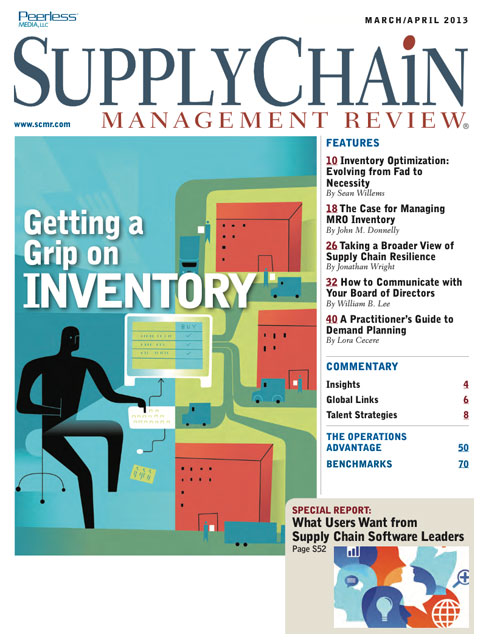Sorry, but your login has failed. Please recheck your login information and resubmit. If your subscription has expired, renew here.
March-April 2013
Inventory needs to be “optimized” to properly match supply and demand. This has become all the more important as competition intensifies globally and supply chains get longer and longer. Learn from a subject matter expert about the benefits of inventory optimization and how to get an IO initiative on track in your organization Browse this issue archive.Need Help? Contact customer service 847-559-7581 More options
As supply chains have become more global, more geographically concentrated, and more efficient, the potential impact of supply chain disruptions has increased dramatically. Accenture’s own research has found, in fact, that significant supply chain disruptions reduce the share price of affected companies by 7 percent on average.
The World Economic Forum first began exploring systemic risks and vulnerabilities to global supply chains and transport networks in 2011. As the WEF noted, the changing nature of these risks, along with their greater potential impact, highlights the need for companies to shift their focus from reactive to proactive risk management. While risks from natural disasters and demand shocks remain highly visible, other emerging risks such as cyber threats, rising insurance, and trade finance costs are leading supply chain managers to look at new mitigation options. Accenture’s research indicates that more than 80 percent of companies are now concerned about supply chain resilience.
The growing concern reflects the changing risk landscape and particularly the emergence of system-wide risks. Unlike localized or company-specific risks, system-wide risks are those which disrupt supply chains across multiple locations and a wide geographic area. They are created—or magnified—by the way supply chain systems are configured, so they are not easily resolved by individual actors. In a globalized, interconnected world, any major disruption—from an epidemic to a fire—has the potential to cascade through supply chains and permeate other systems.
 |
This complete article is available to subscribers
only. Click on Log In Now at the top of this article for full access. Or, Start your PLUS+ subscription for instant access. |
Not ready to subscribe, but need this article?
Buy the complete article now. Only $20.00. Instant PDF Download.
Access the complete issue of Supply Chain Management Review magazine featuring
this article including every word, chart and table exactly as it appeared in the magazine.
SC
MR
Sorry, but your login has failed. Please recheck your login information and resubmit. If your subscription has expired, renew here.
March-April 2013
Inventory needs to be “optimized” to properly match supply and demand. This has become all the more important as competition intensifies globally and supply chains get longer and longer. Learn from a subject… Browse this issue archive. Access your online digital edition. Download a PDF file of the March-April 2013 issue.
 |
Download Article PDF |
As supply chains have become more global, more geographically concentrated, and more efficient, the potential impact of supply chain disruptions has increased dramatically. Accenture’s own research has found, in fact, that significant supply chain disruptions reduce the share price of affected companies by 7 percent on average.
The World Economic Forum first began exploring systemic risks and vulnerabilities to global supply chains and transport networks in 2011. As the WEF noted, the changing nature of these risks, along with their greater potential impact, highlights the need for companies to shift their focus from reactive to proactive risk management. While risks from natural disasters and demand shocks remain highly visible, other emerging risks such as cyber threats, rising insurance, and trade finance costs are leading supply chain managers to look at new mitigation options. Accenture’s research indicates that more than 80 percent of companies are now concerned about supply chain resilience.
The growing concern reflects the changing risk landscape and particularly the emergence of system-wide risks. Unlike localized or company-specific risks, system-wide risks are those which disrupt supply chains across multiple locations and a wide geographic area. They are created—or magnified—by the way supply chain systems are configured, so they are not easily resolved by individual actors. In a globalized, interconnected world, any major disruption—from an epidemic to a fire—has the potential to cascade through supply chains and permeate other systems.
 |
SUBSCRIBERS: Click here to download PDF of the full article. |
SC
MR

Latest Supply Chain News
- Technology’s role in mending supply chain fragility after recent disruptions
- Tech investments bring revenue increases, survey finds
- Survey reveals strategies for addressing supply chain, logistics labor shortages
- Israel, Ukraine aid package to increase pressure on aerospace and defense supply chains
- How CPG brands can deliver on supplier diversity promises
- More News
Latest Podcast

 Explore
Explore
Latest Supply Chain News
- Technology’s role in mending supply chain fragility after recent disruptions
- Tech investments bring revenue increases, survey finds
- Survey reveals strategies for addressing supply chain, logistics labor shortages
- Israel, Ukraine aid package to increase pressure on aerospace and defense supply chains
- How CPG brands can deliver on supplier diversity promises
- How S&OP provides the answer to in-demand products
- More latest news
Latest Resources

Subscribe

Supply Chain Management Review delivers the best industry content.

Editors’ Picks





